How to use 'dry' cleaning for dust, 'wet' cleaning for stubborn spots and smears.
The sensors in digital SLRs do sometimes need cleaning. The usual problem is dust spots, and although many cameras now have dust removal systems which briefly vibrate the sensor (or a filter in front) to dislodge any dust, these are not always effective. Some dust is just too 'sticky'.
Cameras without in-built sensor-cleaning systems are more prone to dust spots, and the image above shows what they look like (dark, diffuse spots).
Sometimes, the sensor can also pick up smears. These aren't as obvious in their effects as dust spots, but can cause subtle streaking effects or reduced resolution and contrast. Smears may be caused by lubricant spraying from the mirror mechanism (a problem on some Canon cameras, illustrated above), or by previous cleaning attempts. If you're not careful when using a sensor swab, you can drag lubricants from around the sensor mount and on to the sensor surface itself.
Depending on the problem (dust or smears), there are two approaches you can take to sensor cleaning: 'dry' cleaning and 'wet' cleaning.
'Dry' cleaning
This is sometimes done with a blower, but often these simply stir up dust inside the camera body and make the problem worse. Usually, a brush is the best solution, but it has to be a special sort. An ordinary brush, like those sold as camera cleaning accessories, is no good because the fibres collect dust and grease over time. They'll just leave the sensor a whole lot dirtier than it was before.
Instead, you need a specialised sensor brush, like Visible Dust's Arctic Butterfly. This uses electrical charge to pick up dust on the sensor surface, and this charge is generated by spinning the brush (it has a battery and motor) for a period of several seconds before passing it gently across the sensor surface. It may take a few attempts to remove any dust, but the risk of contamination or abrasion damage is much lower.
'Wet' cleaning
This may not be enough, and some people find that a dry clean with a specially-designed sensor 'swab' (below) may shift particles that a brush won't. It's more usual, though, to use swabs as part of a 'wet' clean, in conjunction with a specially-formulated sensor cleaning solvent.
Swabs are shaped like paddles in sizes designed to match APS-C or full-frame sensors (make sure you get the right size). They are sold in individually sealed packages and can only be used one. The fluid you use is crucial too. Ordinary lens cleaning fluid is no good; it has to be proper sensor cleaning fluid.
The trick with sensor cleaning is to stop when you've done enough, but it can be pretty hard to work out when that is with the naked eye. It's usually worth investing in a sensor loupe (below), which combines a magnifying lens with small lamps which illuminated the sensor surface.
If you send your camera away to be professionally cleaned, the technicians will be using the same materials and techniques we're describing here. Hopefully, they'll have the benefit of experience and will do a better job than you could, though you can't always rely on that.
One final word of warning. If you scratch your sensor when cleaning it, it's your responsibility and you will have to pay for a repair, whether or not the camera is still within its warranty period.



